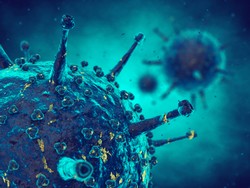Insight into retrovirus infectivity
The protein Nef of primate lentiviruses such as HIV-1 is required to sustain virus replication in the host and retain virus infectivity. In addition, Nef seems to increase viral resistance to neutralising antibodies through a yet unidentified mechanism. Scientists of the EU-funded NEF-FACTORS (Understanding molecular mechanisms and pathogenic functions of Nef-like retrovirus infectivity factors) project wished to further explore the mechanism of action of Nef and understand how it protects viral particles from immune responses. For this purpose, they used different cell lines of haematopoietic origin and identified an unknown inhibitor of HIV, which is counteracted by Nef. Through gene expression analysis, the consortium identified candidate molecules responsible for the inhibitory phenotype. In particular, a transmembrane protein, called SERINC5, was identified as a potent inhibitor of retroviruses. SERINC5 efficiently incorporated into retroviral particles and impaired their ability to infect target cells by interfering with their capacity to deliver the viral content into the cytoplasm. In addition, it modulated the susceptibility of HIV to neutralising antibodies. The team discovered that Nef and glycosylated Gag can remove SERINC5 from the surface, leading to the production of highly infectious virus particles. Equine infectious anaemia virus seems to have evolved a SERINC5-antagonising factor (S2), underscoring the importance of SERINC5 in the interaction of a number of viruses with the host. SERINC5 is evolutionary conserved, and it retains the inhibitory effect on retrovirus infectivity in all animal species. Furthermore, researchers discovered that SERINC proteins stimulate the expression of several secreted antimicrobial genes, thereby playing a broader role against anti-microbial responses. Overall, the findings of the study provide compelling evidence on the role of Nef in retrovirus infectivity. Considering the millions of people living with HIV worldwide, the antiviral activity of SERINC proteins is expected to lead to the design of novel antimicrobial strategies.







